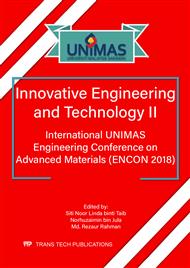[1]
O'regan, B., & Grätzel, M. (1991). A low-cost, high-efficiency solar cell based on dye-sensitized colloidal TiO2 films. nature, 353(6346), 737.
DOI: 10.1038/353737a0
Google Scholar
[2]
Hagfeldt, A., Boschloo, G., Sun, L., Kloo, L., & Pettersson, H. (2010). Dye-sensitized solar cells. Chemical reviews, 110(11), 6595-6663.
DOI: 10.1021/cr900356p
Google Scholar
[3]
Wang, P., Zakeeruddin, S. M., Moser, J. E., & Grätzel, M. (2003). A new ionic liquid electrolyte enhances the conversion efficiency of dye-sensitized solar cells. The Journal of Physical Chemistry B, 107(48), 13280-13285.
DOI: 10.1021/jp0355399
Google Scholar
[4]
Ye, M.D., Wen, X.R., Wang, M.Y., Locozzia, J., Zhang, N., Lin, C.J. & Lin, Z.Q. (2014). Recent advances in dye-sensitized solar cells: from photoanodes, sensitizers and electrolytes to counter electrodes. Materialstoday, 18(3),155-162.
DOI: 10.1016/j.mattod.2014.09.001
Google Scholar
[5]
Wang, P., Zakeeruddin, S. M., Moser, J. E., Humphry-Baker, R., & Grätzel, M. (2004). A solvent-free, SeCN-/(SeCN)3-based ionic liq-uid electrolyte for high-efficiency dye-sensitized nanocrystalline so-lar cells. Journal of the American Chemical Society, 126(23), 7164-7165.
DOI: 10.1021/ja048472r
Google Scholar
[6]
Su'ait, M. S., Rahman, M. Y. A., & Ahmad, A. (2015). Review on polymer electrolyte in dye-sensitized solar cells (DSSCs). Solar En-ergy, 115, 452-470.
DOI: 10.1016/j.solener.2015.02.043
Google Scholar
[7]
Wu, J., Lan, Z., Lin, J., Huang, M., Huang, Y., Fan, L., & Luo, G. (2015). Electrolytes in dye-sensitized solar cells. Chemical reviews, 115(5), 2136-2173.
DOI: 10.1021/cr400675m
Google Scholar
[8]
Shi, Y., Zhan, C., Wang, L., Ma, B., Gao, R., Zhu, Y., & Qiu, Y. (2009). The electrically conductive function of high-molecular weight poly (ethylene oxide) in polymer gel electrolytes used for dye-sensitized solar cells. Physical chemistry chemical physics, 11(21), 4230-4235.
DOI: 10.1039/b901003c
Google Scholar
[9]
Wu, J.H., Lan, Z., Hao, S.C., Li, P.J., Lin, J.M., Huang, M.L., Fang, L.Q. and Huang, Y.F. (2008). Progress on the electrolytes for dye-sensitized solar cells. Pure and Applied Chemistry. 80(11), 2241-2258.
DOI: 10.1351/pac200880112241
Google Scholar
[10]
Kadir, M.F.Z., Majid, S.R. & Arof, A.K. (2010). Plasticized chitosan–PVA blend polymer electrolyte based proton battery. Electro-chimica Acta. 55(4), 1475-1482.
DOI: 10.1016/j.electacta.2009.05.011
Google Scholar
[11]
Riva, R., Ragelle, H., Rieux, A.D., Duhem, N., Jerome, C. and Preat, V. (2011). Chitosan and chitosan derivatives in drug delivery and tissue engineering. Springer. 244, 19-14.
DOI: 10.1007/12_2011_137
Google Scholar
[12]
Xiong, Y.B., Wang, H., Wu, C.Y. & Wang, R.M. (2011). Preparation and characterization of conductive chitosan–ionic liquid composite membranes. Polymers for Advance Technologies. 23(11), 1429-1434.
DOI: 10.1002/pat.2061
Google Scholar
[13]
Mourya, V.K. & Inamdar, N. (2009). Trimethyl chitosan and its applications in drug delivery. Journal of Materials Science. 20:1057.
DOI: 10.1007/s10856-008-3659-z
Google Scholar
[14]
Sudhakar, Y.N. & Selvakumar, M. (2012). Lithium perchlorate doped plasticized chitosan and starch blend as biodegradable polymer electrolyte for supercapacitors. Electrochimica Acta. 78, 398-405.
DOI: 10.1016/j.electacta.2012.06.032
Google Scholar
[15]
Buraidah, M.H., Teo, L.P., Majid, S.R. & Arof, A.K. (2009). Ionic conductivity by correlated barrier hopping in NH4I doped chitosan solid electrolyte. Physical B: condensed Matter. 404(8-11), 1373-1379.
DOI: 10.1016/j.physb.2008.12.027
Google Scholar
[16]
Yahya, W.Z.N, Meng, W. T, Khatani, M., Samsudin, A., Mohamed, N.M. (2017). Bio-based chitosan/PVDF-HFP polymer blend for quasi-solid state electrolyte dye sensitized solar cells. e-polymers, 17(5), 355-361.
DOI: 10.1515/epoly-2016-0305
Google Scholar
[17]
Yusof, S. M. M., & Yahya, W. Z. N. (2016). Binary ionic liquid electrolyte for dye-sensitized solar cells. Procedia engineering, 148, 100-105.
DOI: 10.1016/j.proeng.2016.06.453
Google Scholar


